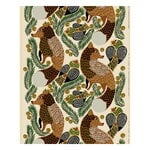Marimekko's Pieni Ketunmarja cotton-linen fabric features Aino-Maija Metsola's enchanting animal pattern in alluring, warm shades. In the Ketunmarja (foxberry) print, foxes have snuck into the garden at night and are hiding under the trees.
Printed in Helsinki, Finland, the Pieni Ketunmarja fabric is made of an unbleached, partly recycled cotton-linen blend and finished with golden metallic pigments. The fabric is perfect for sewing a custom tablecloth or curtains, for example. Please note that in a cotton-linen fabric, the print dye is absorbed in the fabric differently than in a 100% cotton fabric – the surface, therefore, feels a little harder.





